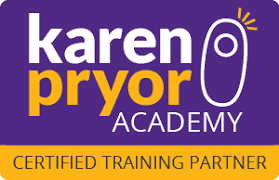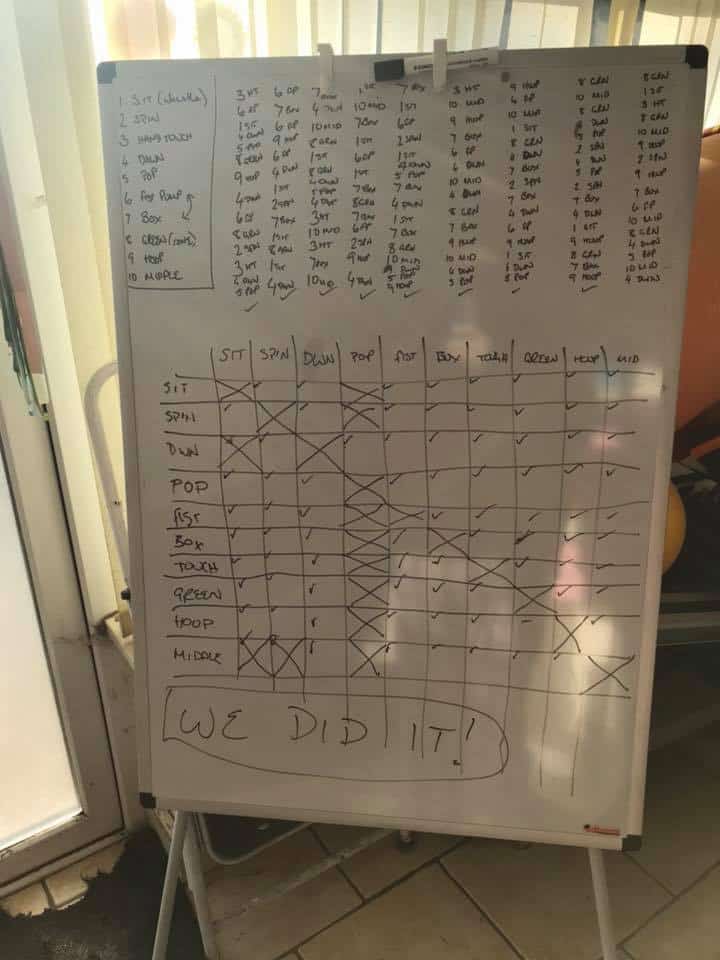In my last post I said that I hadn’t heard whether I had successfully graduated from the Karen Pryor Academy Professional Course that had taken up so much of my time in 2018. Well I’m thrilled to be able to tell you that just before Christmas I found out that Flint and I had indeed graduated and I can now call myself a Karen Pryor Academy Certified Training Partner – or KPA CTP if you prefer.
I also didn’t tell you that Alison did the course along with me. Alison helps me out with the admin stuff in the background and is probably the first person you have contact with when you enquire about classes or private help. She also assists during classes and workshops and is my general sounding board and Wonder Woman.
Alison is far too modest for her own good, and generally likes to keep her brilliance on the down-low so I’m delighted to be able to tell you that she and Megan (her working cocker spaniel) also successfully graduated the course and that Alison is also now a KPA CTP.

I think this puts Tails We Win in a somewhat unique position in the area in that each class is supported not by just one certified training instructor, but two. We keep our classes small with just a 2 to 1 ratio of students to instructors so you can be assured of a lot of individual coaching even in our group classes.
A New Year often brings with our a lot of resolutions that normally fall apart about a week in. Often that’s because we decide to change absolutely everything all at once and set goals that are far beyond our reach.
Lofty goals are good to have, but a goal on it’s own with no plan is just a wish. You have to break that goal down into smaller steps, then turn those small steps into tiny daily actions that will get you where you want to go.
In our KPA course one of our final assessments was to demonstrate a sequence of 10 cued behaviours with our dog.
The behaviours had to be fluent – that means the dog should be able to perform the behaviour with speed, accuracy and low latency in any environment. Latency refers to the time lag between the cue being given and the dog starting to respond, we want the dog to respond immediately after the cue is given.
The behaviours had to be under stimulus control – that means that the behaviour is always offered when cued, is not offered in the absence of the cue, is not offered in response to another cue and no other behaviour occurs in response to that cue.
Finally, when we put the 10 different behaviours together in the sequence they had to flow from one to the other without pause – and without the dog anticipating the next cue.
While this looks simple, like most simple things it was not easy. Actually the easiest part of the whole thing was teaching the 10 behaviours. Refining them for fluency and getting them truly under stimulus control was the hard part – and if I’m honest the most boring part.
Teaching new behaviours is fun and exciting most of the time, making them precise and fully on cue involves an awful lot of repetition and careful staging of environments so that you are always making steady progress. It can easily become dull and feel like you aren’t getting anywhere.
So how did I counteract that? I made a commitment to do at least one training session with Flint every day. Alison and I had accountability calls every day when the going got really tough to keep each other on track. I made plans for how to change sessions up and make sure I was training different things at each session. I made games out of our challenges, using props, music, random number generators – I had a whiteboard in our conservatory with reminders about what I was doing so I didn’t have to keep everything in my head. I kept sessions short and kept a diary after each session to reflect on how it went.

On our final assessment it couldn’t have gone much better. Flint was focussed and motivated and ran through our sequence like a complete pro. Even now thinking back on it brings tears to my eyes because I was, I am, so freaking proud of us.
Does this approach sound similar to anyone that has undertaken a behaviour package with me? I don’t just give you some goals and a bit of a plan. I give you those daily steps to take, and options for accountability and reflection that work for you. I’ll challenge you and celebrate your successes – and make you celebrate them too. And because I know that behaviour change is an ongoing process I’ve got options for you after a package too, so that you aren’t just set adrift but can start to learn to skipper your own boat until you’re ready to chart your own course.
So if you’ve got some resolutions for 2019 but know you really need help with making it a plan get in touch at contact@tailswewin.co.uk and Alison Extraordinaire will give you your next steps.
There’s also still time to sign up to our Come Back! to develop that all important recall class starting on 20th January. Then our Behave! course for those everyday life skills and our new look scent programme start on 29th January. We’d love to see you.
